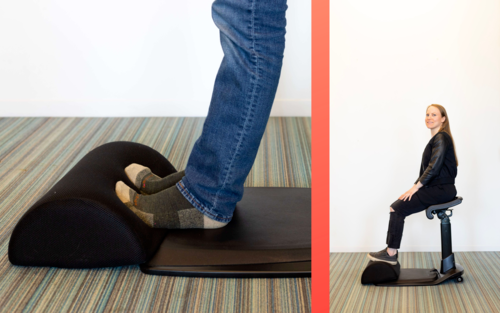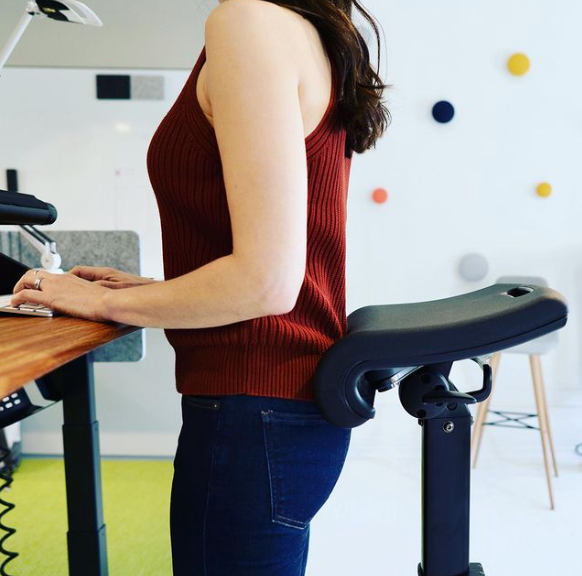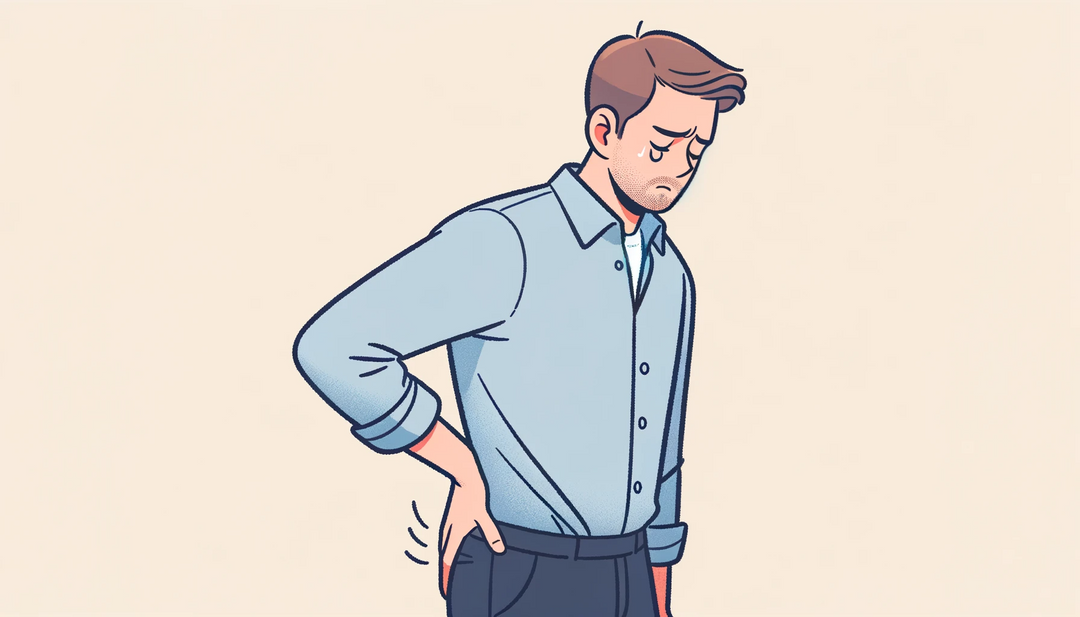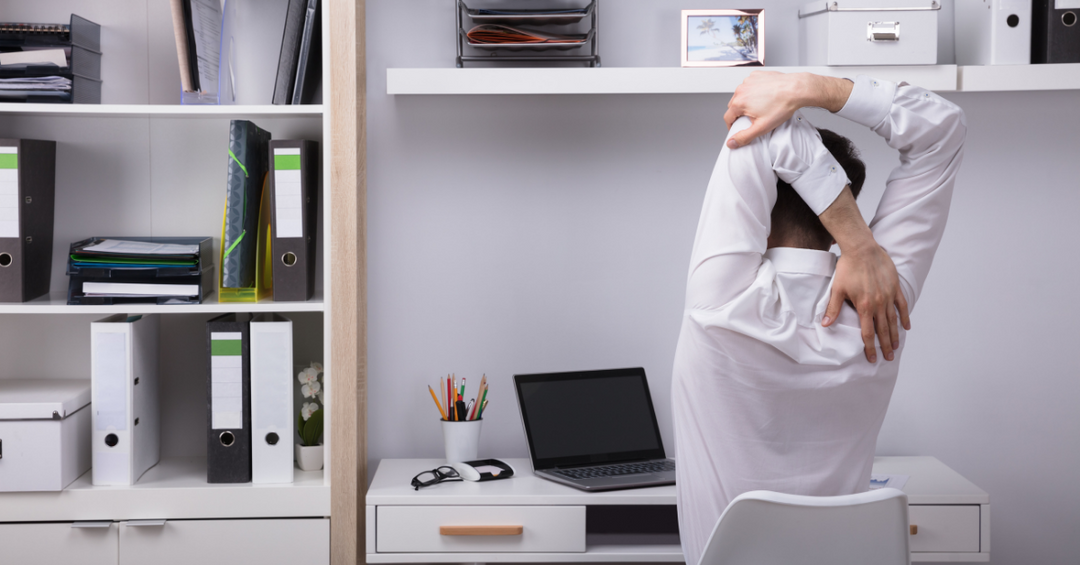The Ergonomic Footrest: an Essential Accessory to Any Desk — Sitting, Standing, or Height-adjustable

An ergonomic under desk footrest is a tool that our team considers essential to any style of desk. Whether you sit, stand, or do a mix of both throughout the day, it’s an absolute game-changer for your comfort and overall well-being.
The principle of a footrest: support + movement
Elevate your feet in a comfortable position and give yourself more places to rest them. The concept behind the ergonomic desk footrest is simple but powerful. When you have more places to rest your feet, you are more likely to move your legs around throughout the day. Options encourage subtle variety in postures — or movement. And movement at the desk is comfortable, healthy, and energizing.
Principle #1: Elevate your feet at a height comfortable for your body
Principle #2: Allow and facilitate movement

The foot cushion gives the calves a comfortable stretch while the LeanRite™ gives users fine-grain control over the distribution of weight between their feet and their glutes, helping to reduce low back pain and fatigue
Benefits of using a footrest, whether you work at a sitting, standing, or adjustable-height desk
-
Prevent computer-work and posture-related RSI’s by elevating feet and legs to a comfortable, healthy height
-
Improve posture and reduce back pain by facilitating more ergonomic postural angles through the entire body
-
Move more at the desk
-
Prevent numbness aches fatigue and stiffness that result from static muscles — by moving more
-
Improve circulation
-
Increase energy levels
-
Heighten focus — especially with active footrest
→ Note: We delve into the specific benefits of using a footrest at each style of desk below
Kinds of footrests: stationary, swinging, rocking, and beyond…
Any quality footrest will elevate your feet at a height comfortable for your body. Where movement comes into play is where things get interesting — different models facilitate different kinds of movements: think tilting, swinging, swaying, or rocking...
The more basic products include the simple foot bar, stool, rail, or cushion, the leg rest, or the slant, incline, or calf stretch board. These give you a comfortable place to set your feet and stretch out.
The more advanced products include the foot swing, rocker, hammock, fidget bar, or peddler. Think of these as active or dynamic footrests. The concept behind these active footrests is something we talk about a lot: the body thrives when in motion. And an active, dynamic footrest simply allows you to keep your legs and feet in motion as you naturally want to. Many products on the market are silent and well-designed; your colleagues won’t even notice that your feet and legs are moving beneath the desk.
Different models will also be surfaced with different materials — some have a bumpy surface to allow you to massage your feet and encourage circulation. Most foot cushions are covered with a comfortable plush microfiber fabric or a microbead grip-covered fabric that provides a sort of anti-slip tread. And many hard footrests will be surfaced with an industrial texture similar to sandpaper. Here’s a link to our favorite footrest.
→ Note: Before you hit the market, consider what kind of shoes you typically wear at your desk and whether you’d like to work barefoot or in your socks from time to time — this may influence what model you choose.
An ergonomic footrest makes sitting more comfortable — and encourages active sitting
Recall how bummed out you’d be in high-school when the desk in front of you didn’t have a footrest. Wanting to elevate your feet while sitting at a desk is a natural desire.
And a footrest not only supports the feet at a height comfortable for your body. It encourages active, or dynamic sitting — or movement at the desk. Even a stationary footrest encourages movement by giving you more, comfortable places to set your feet — wider or closer together on its rigid platform or at different points on the curve of its cushion, for instance.
A footrest that adjusts in angle is built with a wide platform that rotates forward and backward. You can adjust it to rest your feet at different points of flexion and extension throughout the day, facilitating this awesome variety in your posture — or, again, movement.
And an active or dynamic footrest encourages active sitting by the obvious means: it allows you to rock, swing, and sway your feet beneath your desk as you sit.

A cushion footrest + adjustable-height chair in sitting position: The ErgoFoam Ergonomic Under Desk Foot Rest complements our LeanRite™ Elite standing desk chair perfectly
Benefits of using a footrest while sitting at the computer
-
Elevate your feet to a comfortable height — namely, the ideal angle that prevents the hips from locking and tightening up and also relieves pressure on the feet, back, knees, and legs
-
Start sitting ‘actively’ by placing your feet at various spots on the footrest throughout the day, facilitating movement at the desk
-
Improve circulation and increase energy levels by moving more
-
Shorter individuals can place their feet firmly on the footrest to fix the ‘feet dangle’ problem and restore healthy circulation through the legs
-
Rest, flex, and stretch calves, ankles, and feet
-
Find your comfortable and natural posture, given more options on working postures
A footrest allows you to stand — actively, comfortably, and engaged — for longer periods of time
Consider how much more comfortable and relaxed you are made when you are able to rest your foot on the bar stool or foot rail when ordering a drink.
Elevating one foot at a time when working at a standing desk is a natural stance because shifting the weight between the body is a desire that contributes to comfort. In this sense, a footrest is simply a tool that allows us to move as we innately want to.
[picture]
In his incredible book Deskbound: Standing up to a Sitting World, Physical Therapist Dr. Kelly Starrett applauds the footrest. He has focused much of his career on teaching people how to find comfort, strength, and mobility at the desk. And he considers a standing or adjustable-height desk setup incomplete without a quality footrest.
Propping one foot up on a rail is the easiest way to remove the load from your lumbar spine... Simply put, a foot rail makes it easier to stand comfortably for longer periods. In fact, having some kind of foot support is so critical that we don’t consider a standing workstation complete or acceptable if it doesn’t give you a place to rest your feet.-Dr. Kelly Starrett, author of Deskbound: Standing Up to a Sitting World
In his book, he demonstrates a variety of functional standing positions. Variety is the key — as we ergo nerds always like to say: the best posture is the next posture. And a footrest affords more of this variety in posture by giving you different places to elevate one foot at a time when working at a standing desk.
If one of your goals in taking the standing desk on was simply to move more at the desk, we can pretty much guarantee that a footrest will help you along your journey.
Benefits of using a footrest when doing standing work at the computer
-
Shift weight between feet, elevating one foot at a time as comfortable
-
Stand comfortably for longer periods by shifting weight between legs, engaging the muscles and improving blood flow
-
Find your comfortable and natural posture, given more options on working postures
-
Rest, flex, and stretch calves, ankles, and feet
A footrest offloads the stress of working in a perching or leaning posture
In our last blog on posture at the desk, we reviewed recent research comparing the effects of sitting, standing, and perching postures. The key finding was that a perch posture (a hybrid between sitting and standing) may be ideal for those with low back pain. The data showed that perching puts less stress on the spinal column than both sitting and standing.
The research team observed an important trade-off, however: a perching posture can put more of a load on the lower limbs — i.e. the feet and legs.
A footrest can help to offload this extra weight on the lower body.
To borrow directly from the study,
This increase in lower limb demand occurs as a result of having to resist the upper body mass from sliding forward and down from the seat pan as the seat pan used in this study was flat and had minimal surface friction. If this magnitude of loading is maintained for a prolonged period of time, it is possible to experience an increase in discomfort (Mak, Zhang, and Tam 2010) and muscle overload due to the static and prolonged (i.e. without breaks) nature of the exposure (Jonsson 1978). One way to reduce lower limb demands is by implementing an appropriate foot support system (Antle, Vezina, and Cote 2015); for example, a foot rest that can align the ankle in a neutral posture and the shank angle parallel to the direction of the resultant ground reaction force.-Are hybrid sit–stand postures a good compromise between sitting and standing?
In simpler terms, a footrest makes a perching or leaning posture more comfortable on the lower back while offloading some of the extra weight on the legs and feet.
→ Don’t know what perching is? Read our blog post dedicated to the ‘perch’ for a breakdown of its benefits — if you have chronic low back pain, it’s worth the 6-minute read: ergoimpact.com/blog/is-perching-the-new-sitting-research-suggests-yes
Check out our LeanRite™ Elite to better understand how a quality standing desk chair makes working at a standing desk comfortable and energizing. If you currently use or are on the market for such a perching or leaning stool to complete your standing desk setup, factor in the footrest. It might be just the tool you need to offload the extra stress of working partially upright — to be able to stand for longer periods of time.

Benefits of using a footrest when leaning or perching
-
Shift weight between feet, elevating one foot at a time as comfortable
-
Rest, flex, and stretch calves, ankles, and feet
-
More control over the distribution of weight between feet and glutes when perching or leaning
-
More comfort and relaxation afforded by the footrest cushion or massaging bumpy surface
Good ergonomics = the right support + the freedom to move
And ‘support + the freedom to move’ are exactly what a footrest affords.
Whether you sit, stand, or do a mix of both at your desk, a footrest is a powerful tool to take your workflow to the next level in terms of comfort, productivity, and energy levels. It improves your ergonomic alignment (or posture) and circulation while bringing more movement to the desk. This reduces aches, pains, fatigue, stiffness, and discomfort that result from static muscles and poor circulation.

A leaning or perching posture demonstrated with our LeanRite™ Elite adjustable-height standing desk chair. The posture is made comfortable by the use of a cushion-style footrest paired with our LeanRite™ elite.







Leave a comment